This pic is just to show that the wood does show. I just don't have the finish done yet. The pic also shows the barrel and lock color same as all the metal. It's about medium grey. I've really had a time trying to get this lined out. It's a SMR from pecatonica. 32 cal.
I sure hope the next one does much better.
In spirit of your last sentence about the next one going better.
First thing, you are a " rifle builder".
You build a good rifle. Your rifles are better than most mid-20th Century (1950s-80s) builds.
You can build a very fine rifle instead of a good rifle.
Here's what I see.
You overdo the lock panels and underdo the architecture.
If you get the architecture right everything pretty much falls into place. The best way I can tell you how to form a lock panel is not to form a lock panel.
Lock panels just appear.
If the lower forestock is right, If the wrist is right, If the tang area is right. If the trigger area or belly of the stock is right, the lock panel will appear as the wood is shaped to or away from the drawn line around the lock. It's just a matter of removing wood and it just appears.
Tweak it, shape until it looks right but do not overdo it.
Tools for this....
A pattern makers rasp I like a #50. This type of rasp is flat and round. (This starts the general shape as you transition from the plane of the forestock and the plane of the lock panel.)
A rattail rasp or course rattail file. (The rattail gives the tighter radius and really helps define the panel.)
Scrapers
flat chisels (sparingly)
Maybe a dowel wrapped in sandpaper......
This helps remove any humps in the transition from the panel to the forestock or wrist. It takes a light touch.
Let's start with the forestock and show the transition to the lock panel....
 Untitled
Untitled by
Travis Brown, on Flickr
^^^^^
One of the basic rules of architecture is that the lower forestock is 1/8" wider than the barrel at it's widest point. The upper forestock is 1/16" wider than the barrel at it's widest point. The photo above is the rear sight where the upper forestock transitions into the lower forestock.
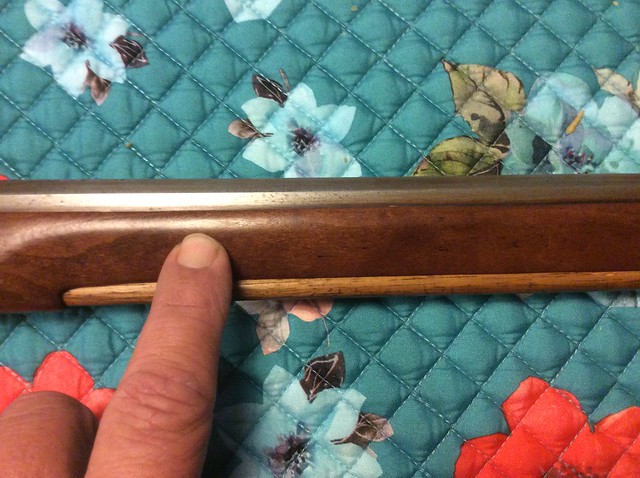 Untitled
Untitled by
Travis Brown, on Flickr
My finger is just below the widest portion of the upper forestock. Notice the glare. The forestock is V'ed on this particular rifle. Above the widest point it rounds into the barrel flat with a feather edge. Notice that most of the ramrod is showing and a great deal of the side barrel flat.
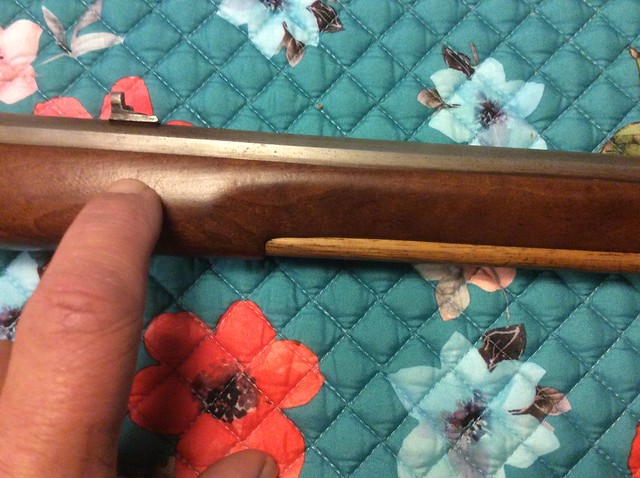 Untitled
Untitled by
Travis Brown, on Flickr
Above, my finger is the widest point of the lower forestock. The forestock is rounded and it to rounds from the widest point into the barrel flat with a feather edge. Notice that it's wide point is below the wide point of the upper forestock. This is common longrifle architecture.
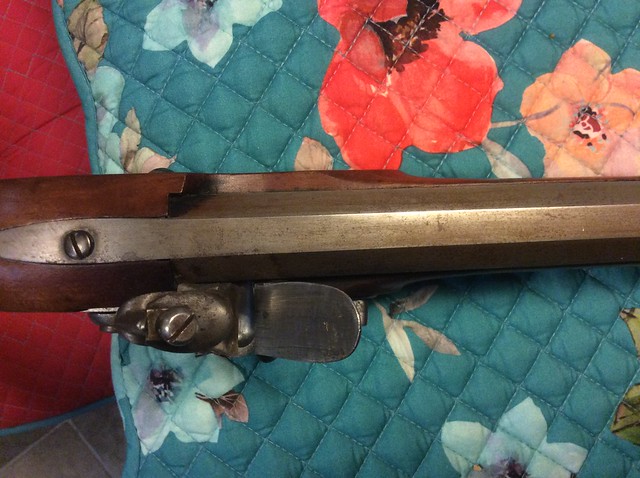 Untitled
Untitled by
Travis Brown, on Flickr
Above you can see the transition from forestock into the side/lock panel. You can really see the detail on the side plate side as the frizzen hides a lot on the lock side. Notice the smooth transition. This is seen on the original 1810 Matthew Gillespie.
Think about how you can use your rasp, file and other tools to make this transition. It's not a blob at the lock, it's a smooth transition.
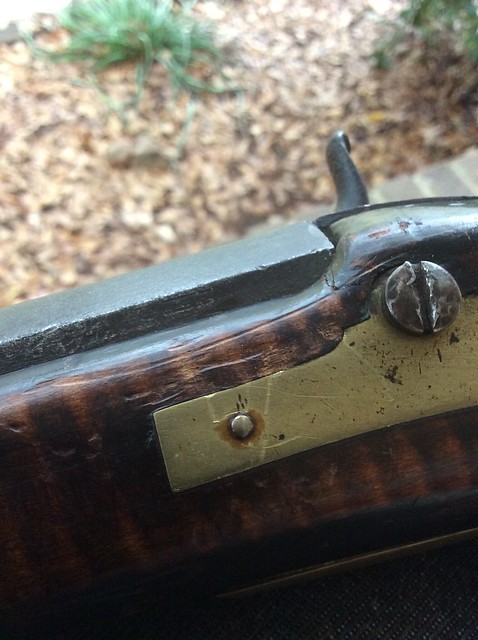 Untitled
Untitled by
Travis Brown, on Flickr
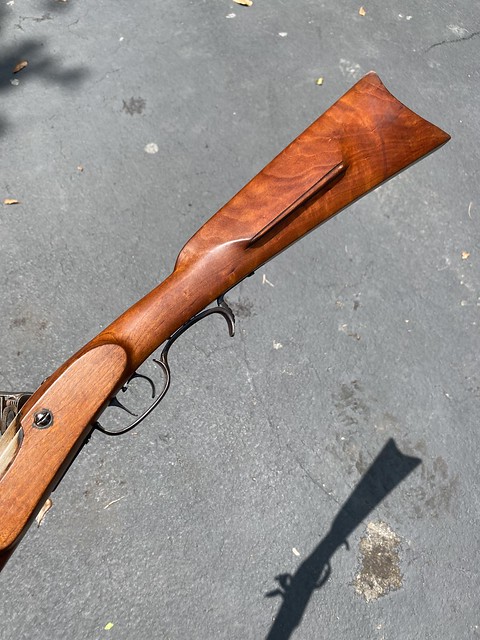 IMG_0443
IMG_0443 by
Travis Brown, on Flickr
An original Jacob Roosa 1840....
My Gillespie....
Notice how the top of the side panel corresponds or continues the line of the side flat of the barrel. Architechture....
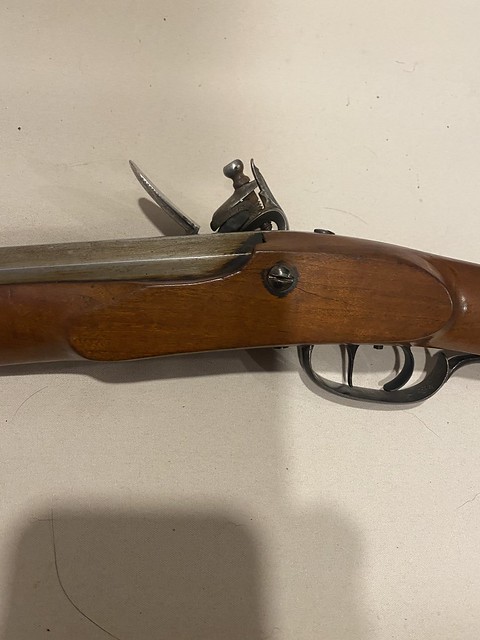 IMG_0446
IMG_0446 by
Travis Brown, on Flickr
The Gillespie Swoop....
Notice how the barrel channel drops revealing a great deal of the side flat and then swoops up into the breech face of the stock. Architectural feature of some Gillespies and early longrifles. Again, notice how the barrel side flat line continues on into the top side panel line. Notice the transition from forestock into the nose of the side panel. Yep, it's cracked. That's what happens when you clean a delicate longrifle like a musket. Heel of the stock on the ground, at an angle.....it was too much for it. I was a little too hard on it at the Fort. You need to clean these delicately.
 Untitled
Untitled by
Travis Brown, on Flickr
Lock side.... It's a little different but they do not have to match perfectly.
Crow, I'm not trying to be critical. I'm trying to help you improve. My rifle has a lot of boo boos, but it does have good architecture.
Study original guns, handle them if you can. Go to shows, get the books.
I priced one of Tracks cheapest kits, It was over 900 bucks for their base kit. That's a lot of dough. That's a lot of money to spend. I hope I have helped some.
I hoped I helped you to start getting the eye for architecture.














